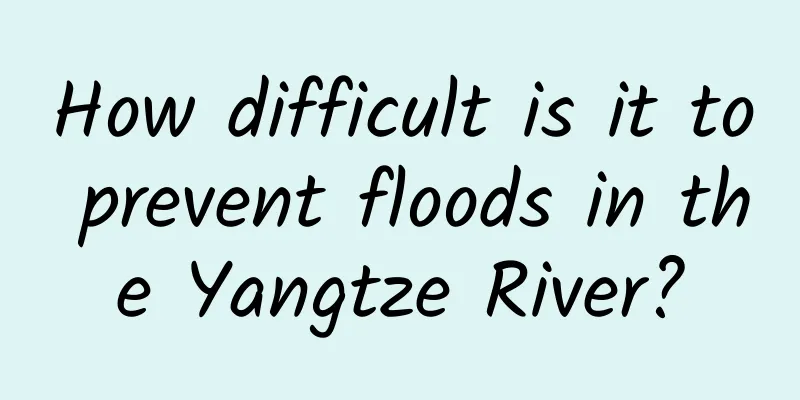How difficult is it to prevent floods in the Yangtze River?

|
↑A group of National Geographic fans, focusing on exploring the extreme world Yangtze The longest river in Asia Our Mother River More than 10,000 tributaries It accounts for 1/3 of the country's runoff. Nourishing nearly 500 million people The basin spans 19 provinces, municipalities and autonomous regions across the country (The Yangtze River flows quietly through the thousand-year-old city of Jingzhou, photographer @邓双) ▼ But the frequent floods in the Yangtze River Another huge disaster 145,000 deaths in 1931 33,000 deaths in 1954 1,526 deaths in 1998 (The above data only includes direct deaths) And when the floods of 2020 Strikes again us How to guard? (The lower part of Guanyin Pavilion in Ezhou City, Hubei Province was submerged by the river. Photographer: @冯光柳) ▼ 01 The Yangtze River originates from the Qinghai-Tibet Plateau Accommodating hundreds of rivers flowing eastward into the sea According to the terrain, it can be roughly divided into Seven regions (Topographic map of the Yangtze River system, please view it in horizontal mode, drawn by @陈志浩/Planet Research Institute) ▼ The westernmost Jiangyuan District High altitude, little rain, and uninhabited The river is flowing freely (Chumar River, the northern source of the Yangtze River, photographer @刘夙培) ▼ Hengduan Mountain Area, Qinba-Wuling Mountain Area The mountains are high and the valleys are deep Floods are bound by topography Difficult to flow Relatively small harm (The Jinsha River flowing through Jin'an Town, Gucheng District, Lijiang City, Yunnan Province, photographer @李祺) ▼ The towns and villages here Most of them are obviously higher than the river level. No need to build tall embankments The main things to be prevented are mountain torrents, mud and rock flows, etc. (Panzhihua City on the Jinsha River is distributed along both sides of the river valley, photographer @君子裕) ▼ The low-lying Sichuan Basin Although water from all directions However, due to the elevation of the terrain Deep river cutting The threat of major flooding is limited to a few areas along the river. (Yibin, with mountains behind and water in front, by the Jinsha River, photographer @Sailor Zheng Zhihua) ▼ The easternmost lower reaches of the Yangtze River From Hukou County, Jiangxi Province to the estuary No major tributaries The river is wide and deep, and it faces the East China Sea to the east. Floods are easy to discharge So here the great flood Often comes from the middle and upper reaches rather than the local The Anhui section of the river, which is close to the middle reaches, is most vulnerable. (The Yangtze River in Wuhu City, Anhui Province, please watch in horizontal mode, photographer @张浩然) ▼ The hinterland of Jianghan-Dongting Basin and Poyang Lake Basin The area most affected by floods This is a low-lying area The former is generally at an altitude of 20-40m The latter is 10-30m Surrounded by mountains Large and small rivers converge towards the center (Sketch of the two major basins in the middle reaches of the Yangtze River, drawn by @陈志浩&郑伯蓉/Planetary Research Institute) ▼ River water and sediment Alluvial deposits create fertile land Densely populated and prosperous economy (Farmlands and towns on both sides of the Han River in the western suburbs of Wuhan, photo courtesy of @VCG) ▼ However, the river drop in the basin is small Water flow is easily blocked Every flood season Floods flowing down from upstream Heavy rain in the area Downstream supporting water flow The three worked together to quickly push up Water levels of mainstream and tributaries Plus The expanding population reclaimed land from lakes and cultivated wasteland Many lakes that can store flood water Significant shrinkage or even disappearance Floods have nowhere to go (Wei fields in Kangshan Township, Yugan County, Jiangxi Province, located southeast of Poyang Lake. Image source: @VCG) ▼ then Since the Eastern Jin Dynasty People living in the basin Begins to build embankments on both sides of the Yangtze River As a basic line of defense against floods But while the dikes restrain the water flow It also prevents sediment from overflowing the river. A large amount of silt accumulates in the river channel and raises the riverbed The levee also had to be raised accordingly. A vicious cycle (The Jingzhou Wanshou Pagoda on the Jingjiang River embankment was built in the Ming Dynasty. As the embankment continues to rise, the base of the pagoda is more than 7 meters below the embankment. Photographer @邓双) ▼ at the same time Subject to technical and economic conditions Many early dikes were not strong enough. The dam often breaks during the flood season Raging floods tore through the levees Washing the surface Often forming deep pools and waterways several meters deep Floods are rampant and causing disasters Wherever he went, houses collapsed and fields were destroyed, and the scene was horrific. (Sketch of the flood inundation area in the middle and lower reaches of the Yangtze River [1870/1931/1954], please watch in landscape mode, drawn by @陈志浩/Planetary Research Institute) ▼ The 1931 Great Flood in the Middle and Lower Reaches of the Yangtze River 145,000 deaths Among them, Hubei has 66,000 and Hunan has 47,000 The 1954 flood in the middle and lower reaches of the Yangtze River 33,000 deaths Among them, Hubei has 31,000 The traces left by the breach Even after a hundred years, it is hard to erase (Image of the breach fan in Wencun, Jingjiang River. The breach fan, also known as the breach fan, was formed by the Wencun breach in 1842. The deep pool formed by the breach was developed into a fish pond, and the waterway was planted with rice and other crops. Map by @陈志浩/星球研究院) ▼ After the founding of New China Especially after the great floods of 1954 and 1998 We fully reinforced and expanded the original embankment Formed a 64,000km long embankment system Hubei, Hunan, Jiangxi and Anhui have the longest Including about 3900km of Yangtze River embankment (The beaches on both sides of the Yangtze River in Anqing City, Anhui Province were flooded, and the river water was approaching the Yangtze River embankment. Photographer @陈肖) ▼ Han River, Xiang River, Gan River, etc. Tributary dikes (Hanjiang River levee in Xiantao City, Hubei Province, with protective forests on both sides of the levee, photographer @李念) ▼ Dongting Lake and Poyang Lake, etc. Lake embankment (Zhuhu Lianwei in Poyang County, Jiangxi Province. The water level of Poyang Lake on the left is high, while the water level of Zhuhu Lake on the right is low and clear due to the protection of the dike. Image source: @VCG) ▼ and urban embankments, etc. (On July 12, 2020, the water level of the Yangtze River in Nanjing Xiaguan has significantly exceeded the city ground. Citizens are walking on the trail on the flood control wall. Image source: @VCG) ▼ In the hinterland of the two low-lying basins Many embankments are higher than towns and villages. The highest place The dike guards Vast plains and towns of all sizes Take the famous Jingjiang section of the Yangtze River as an example It meanders freely across the plains (The meander of the Jingjiang River, with Yueyang City, Hunan Province and the mouth of Dongting Lake on the left. The Jingjiang River refers to the section of the river between Zhicheng, Yichang and Chenglingji, Yueyang. Photographer: @蓑笠张) ▼ The water level in Jingzhou city often exceeds 40m During the 1998 flood Even reaching 45.22m The elevation of the urban area of Jingzhou within the dike is mostly less than 35m As the saying goes "The most dangerous part of the Yangtze River is the Jing River" A strong embankment It has become the local lifeline. (The Jingjiang River embankment is more than ten meters higher than the urban area of Jingzhou. Photographer: Deng Shuang) ▼ Height of the levee Generally designed based on the highest historical flood level Design Water Level Also called guaranteed water level The top of the levee is determined by the importance of the levee, etc. It should also exceed the design water level by 1.0~2.5m To prevent water overflow (On July 23, 2020, the water level of the Yangtze River in Jingzhou Jianli urban area was close to the guaranteed water level. The river water flooded the river beach and approached the top of the levee. Photographer @向源翰) ▼ The levee is built of artificial earth filling in a trapezoidal shape. The foundation often contains sand layers, and the levee also contains sand particles. The pores between sand particles are large Water seepage easily damages the safety of the levee Some levees are also embedded with vertical anti-seepage walls. To prevent levee breach (Sketch of the anti-seepage wall of the levee on the south bank of the Jingjiang River. The water level in this article generally refers to the Wusong elevation. Wusong elevation - Yellow Sea elevation ≈ 1.7m. Map by @王申雯/Planetary Research Institute) ▼ As for Wuhan, which spans two rivers and four banks The city is close to the river Limited space for embankment construction Difficult to raise the height of the embankment So on the basis of the original earth embankment Build flood walls (The flood control wall in front of the Dragon King Temple in Hankou, Wuhan. The river water submerged the riverside trail, which was only separated from the ground inside the dike by a wall. Image source: @VCG) ▼ Flood walls are mainly made of concrete Standing on the river bank Compared with earth filling and embankment Saves construction space The top of the wall can be 3~5m above the ground (Sketch of the flood control wall in Wuchang District, Wuhan, drawn by @王申雯/Planet Research Institute) ▼ While building the embankment We also carried out river regulation projects For example, the Xiajingjiang River straightening project Reduced river meanders Speed up the flow of water in this river section Stronger flood discharge capacity However, this also increases the pressure on flood control downstream (Schematic diagram of the evolution of the lower Jingjiang River, where Zhongzhouzi and Shangchewan are artificial bends, and the lower Jingjiang River refers to the Jingjiang River below Ouchikou. Map by @Chen Zhihao/Planetary Research Institute) ▼ Through embankment reinforcement and river regulation Since 1954, the main tributaries of the Yangtze River There are few breaches. But considering the high embankment High construction costs Occupies a lot of space and affects production and life The flood control capacity of levees cannot be increased infinitely The Jingjiang section of the Yangtze River The flood control standard is only once every 10 years The Wuhan section has a 20-30-year flood Some tributary embankments are even more fragile Therefore, it is difficult to ensure the safety of both sides of the Taiwan Strait We need a second line of defense (On July 16, 2020, after the Fushui flood at the Junken Farm in Yangxin County, Hubei Province, helicopters hoisted nets and dropped rocks to block the flood. The so-called once-in-N-year event means that the probability of a flood of a certain size occurring in a certain year is one in N, not that it only occurs once in N years; Image source: @VCG) ▼ 02 Reservoir floods are fierce When the Yangtze River's flood-carrying capacity is stretched to its limits The upstream reservoir can hold back the flood water. Reduce pressure on downstream river embankments The most famous Three Gorges Reservoir (The Three Gorges Dam, which blocks the river water to form the Three Gorges Reservoir, image source: @VCG) ▼ Due to the severe flood disaster in the Yangtze River Flood prevention is the first task of the Three Gorges Reservoir Power generation comes second Its hydropower installed capacity is as high as 22.5 million kW Far higher than the world's largest hydroelectric power station The 14 million kW Itaipu Hydroelectric Power Station in South America But the power generation of both is similar The main reason is that The Three Gorges Reservoir undertakes the arduous task of flood prevention (The Three Gorges Dam surrounded by clouds and mist, please watch it in horizontal mode, photographer @李心宽) ▼ Winter half year The Three Gorges Reservoir is gradually filled to the normal water level of 175m The corresponding storage capacity is 39.3 billion m³ Much higher than the volume of Poyang Lake Over 100 meters of height difference and plenty of water Can be converted into huge electrical energy But before June 10th of each year The Three Gorges Reservoir will drain the stored water Lower the water level to the flood season limit of 145m To reserve sufficient reservoir capacity for flood control A lot of river water flows away in vain This reduces the amount of power generated (The Three Gorges Dam opens to release floodwaters, image source: @VCG) ▼ Flood control capacity of the Three Gorges Reservoir Up to 22.15 billion m³ More than half of the total storage capacity In early July this year Dongting Lake Chenglingji Station and Poyang Lake Hukou Station The water levels are close to their respective guaranteed water levels The situation is very critical (On July 18, 2020, Luoxingdun in Poyang Lake, Jiujiang City, Jiangxi Province, was submerged in the lake water. Image source: @VCG) ▼ Three Gorges Reservoir urgently cuts discharge flow About 3 billion cubic meters of flood water were intercepted and stored in one week Alleviated the urgent need of the two lakes However, relying solely on the Three Gorges Reservoir Not enough to meet flood control needs So over the decades we have built More than 50,000 reservoirs The total storage capacity is more than 360 billion m³ Equivalent to 9 Three Gorges Reservoirs Formed a Super Reservoir Group Among them, 41 controlled reservoirs The flood control storage capacity reaches 59.8 billion m³ It can hold two Poyang Lakes (Control reservoirs included in the joint dispatching have strong flood control functions and great effects. Map by @陈志浩&王申雯/Planet Research Institute) ▼ Including the Yalong River Ertan and Jinping I reservoirs On the Jinsha River Xiluodu Reservoir (Xiluodu Reservoir between Sichuan and Yunnan, photographer @柴俊峰) ▼ and Xiangjiaba and Wudongde reservoirs (Xiangjiaba Reservoir near Shuifu City, Yunnan Province, photographer @柴俊峰) ▼ Also includes the Danjiangkou Reservoir on the Han River Geheyan and Shuibuya Reservoir on the Qingjiang River Wuqiangxi Reservoir on the Yuanjiang River etc. (Geheyan Reservoir in Yichang City, Hubei Province, please watch in horizontal mode, image source: @VCG) ▼ Through the joint operation of the above reservoirs Flood control standards for the Jingjiang River section From once in 10 years to once in 100 years Far higher than the defense capacity of the levee itself The flood control capacity of the downstream river section has also been improved accordingly. This is also the case despite the frequent floods in recent years. But there has been no flood like the one in 1998. The important reason for that passive situation (The flood control function of the Three Gorges Reservoir is shown in Figure 1. Comparison of the inundation range of the Three Gorges Reservoir in the event of a flood similar to the 1870 flood. Map by @陈志浩/Planetary Research Institute) ▼ Furthermore To avoid siltation and reduce the reservoir capacity We also implemented Key soil and water conservation projects Through afforestation, returning farmland to forest and grassland, etc. Effectively reduced soil erosion in the Yangtze River Basin (Artificial forest in Yakou Village, Baixing Town, Nayong County, Bijie City, Guizhou Province, photo courtesy of @VCG) ▼ certainly Even if there are tens of thousands of reservoirs But we still cannot "tame" the unruly Yangtze River first Compared with the Yangtze River runoff of nearly 1 trillion m³ Flood control storage capacity is still insufficient And the reservoir cannot be increased indefinitely. It requires a lot of land For China, which has a large population and limited land, The cost is huge (The emerald green water of the Qingjiang Geheyan Reservoir, photo courtesy of @VCG) ▼ Secondly Most of these reservoirs are located in the upper reaches of the Yangtze River. However, the middle and lower reaches of the Yangtze River, which are most affected by frequent rainstorms, But because of the flat terrain Difficult to build a reservoir Even as big as the Three Gorges For the river section below Wuhan, which is far away The flood control effect is also very limited (Shuibuya Reservoir, Qingjiang River, Enshi Prefecture, Hubei Province, photographer @李云飞) ▼ therefore We also need The third line of defense 03 When levees and reservoirs appear in flood storage areas When there is an excessive flood that no one can resist Flood storage area Then he appeared It is low-lying The outer perimeter is a tall embankment There are gates on the dike Keep flood water out during normal times The gates are opened during flood diversion Bringing floodwaters into the house (Poyang Lake Kangshan area in Yugan County, Shangrao City, Jiangxi Province. The lower right of the levee is the Kangshan flood storage area, and the upper left is Poyang Lake. Image source: @VCG) ▼ In 1870 Peak flow of the Yangtze River mainstream in Yichang Once as high as 105000m³/s Far exceeds the flood discharge capacity of the Jingjiang River section With such flow It only takes more than 130 seconds to fill Hangzhou West Lake The flood control capacity of the Three Gorges Reservoir can be filled in 2.5 days (The old Huangling Temple downstream of the Three Gorges Dam. The great flood of 1870 submerged the pillars of the Yuwang Hall in the temple. Image source: @VCG) ▼ Although the Three Gorges Reservoir and other The flow rate can be reduced to less than 80000m³/s But this is still beyond the tolerance of Jingjiang This is when we need a flood storage area. Spring 1952 It took only 75 days for 300,000 soldiers and civilians to The construction of the Jingjiang flood diversion area was completed. The flood diversion area is 921km² Almost 1/4 of Poyang Lake The effective flood storage capacity can reach 5.4 billion m³ 1/4 of the Three Gorges Reservoir (Sketch of the Jingjiang flood diversion area, drawn by @陈志浩&王申雯/Planetary Research Institute) ▼ Just two years later in 1954 The greatest flood of the 20th century is coming There were three flood diversions here. Successfully lowered the water level of the Jingjiang River section Avoided greater danger This practice fully proves that The Correctness of Building Flood Storage Areas (Across the Jingzhou urban area, the Buhe Town of Gong'an County in the Jingjiang flood diversion area is distributed along the levee. Photographer @邓双) ▼ at present The main stream of the middle reaches of the Yangtze River has been built 42 major flood storage areas Total area: approximately 12,000 km² Equivalent to two Shanghai cities The effective flood storage capacity is 58.97 billion m³ Equivalent to the flood control capacity of the Yangtze River control reservoir group (Distribution of flood storage areas in the middle and lower reaches of the Yangtze River, please watch in landscape mode, map by @陈志浩/星球研究院) ▼ These flood storage areas are located in Both sides of the Yangtze River and around Poyang Lake and Dongting Lake For example, the Jingjiang flood diversion area As the only Key flood storage areas It is of vital importance to the safety of the Jingjiang River section It is the "leader" of flood storage areas Near Wuhan Shenhu Lake Dujiatai flood storage area It is the guardian of Wuhan, Hanchuan, Xiantao and other places. (The Dujiatai flood diversion gate on the Hanjiang River in Xiantao City, Hubei Province, is the water intake gate of the Dujiatai flood storage area. It has been used more than 20 times since its completion in 1956. Photographer @尹权) ▼ also Since 1998 Middle and lower reaches of the Yangtze River The island beach dikes that seriously hinder the flow of floodwaters The projects of leveling embankments to allow floodwater to flow and returning farmland to the lake were successively carried out. Increased flood storage capacity by billions of cubic meters (In 2016, Hubei Province permanently blasted a dike in Liangzi Lake in Wuhan to return the dike to the lake. Image source: @荆楚网) ▼ However Although flood storage areas play a great role But there are often a lot of farmland and towns in it Residents must be relocated before flood diversion Farmlands, houses, factories, etc. that cannot be moved will be submerged in water Therefore, unless absolutely necessary Flood storage areas will not be easily activated 04 The Invisible System On the Night of August 16, 1998 Jingjiang River embankment Facing floods that far exceed the design flood control capacity We evacuated the Jingjiang flood diversion area. More than 300,000 people in Gong'an County The explosives for blasting the anti-siltation embankment have also been buried (North Gate of the Jingjiang Flood Diversion Area. During flood diversion, floodwaters will flow into Gong'an County from here. The Jingjiang River is in the distance. Photographer: Deng Shuang) ▼ If floodwaters are diverted, hundreds of thousands of people will be displaced Decades of accumulated wealth will vanish into thin air If there is no flood diversion The river embankment from Jingzhou to Wuhan may breach at any time. The losses will be even greater (People in Wuhan wading through water during the 1998 flood, photo courtesy of @VCG) ▼ On that sleepless night Broadcasting in the flood zone Constantly broadcasting news of the upcoming flood diversion Patrol personnel continue to send out warning signals The People's Liberation Army is already on standby at the Beizha anti-siltation embankment Residents in the flood diversion area look at their hometown that is about to be flooded Experts from all parties held emergency consultations with the National Flood Control and Drought Relief Headquarters think Although the peak water level exceeded the historical record But we can survive by strictly guarding the levee Flood diversion is not recommended final “The Republic has not opened the floodgates” Millions of soldiers and civilians along the coast are on high alert The main stream of the Yangtze River has not breached again The homes of more than 300,000 people were saved. (On the morning of September 15, 1998, the first batch of more than 6,000 people's soldiers successfully completed the flood control and disaster relief mission and evacuated Jiujiang, Jiangxi; 250,000 Jiujiang citizens shed tears and sent their loved ones on their journey home. Photographer @周国强) ▼ Behind successful decision making It is an invisible system It constitutes Outside the three lines of defense of dikes, reservoirs, and flood storage areas The last line of defense In this system More than 30,000 hydrological and meteorological stations A monitoring network consisting of satellites Real-time monitoring and feedback of water and rainfall information Providing a basis for flood control decision-making (Hukou Hydrological Station at the mouth of Poyang Lake, image source: @VCG) ▼ From academicians of the two academies to professional and technical personnel Expert Team Analyze flood situations and predict future trends Propose flood prevention solutions From the State Flood Control and Drought Relief Headquarters To the grassroots organizations in various places Administrative system Dispatch flood prevention personnel and materials Decision-making and implementation of flood prevention plans and measures (Vehicles transporting earth and rocks to the Xiushui Sanjiao Lianwei breach in Yongxiu County, Jiangxi Province, photographer @胡寒) ▼ From the People's Liberation Army to the local residents Frontline staff Inspection and reinforcement of embankments Carry out emergency rescue (PLA soldiers are carrying out anti-filtration operations to prevent water seepage hazards on the levee. Image source: @东战区 WeChat official account) ▼ This invisible system Coordinate and run Tens of thousands of kilometers of dikes Tens of thousands of reservoirs Dozens of flood storage areas and countless gates, stations, channels, pumps, etc. (Sanchawan Water Conservancy Project on Chuhe River in Nanjing, Jiangsu Province, photographer @周文军) ▼ These four lines of defense Together they form a protective network to protect the safety of the Yangtze River Protecting 1.8 million km² of land Protecting nearly 500 million people Protecting 40% of the country’s GDP Protecting 30% of the country’s grain production It is with these four lines of defense We can “No matter how strong the wind and waves are, it is better than strolling in the garden” (On July 13, 2020, the river water in Wuhan city was about to flood the roof of the Huanghuaji Pavilion. Members of the Yangtze River Rescue Volunteer Team patrolled in the water. Photographer: @张乔) ▼ Creative Team Written by: Wang Chaoyang Photos: Jiang Zherui, Xie Yuhan Design: Wang Shenwen, Zheng Borong Map: Chen Zhihao Proofreading: Lushumao, Yunwukongcheng Cover image source: VCG PS: During the writing of this article, Zheng Shouren, an academician of the Chinese Academy of Engineering, a famous expert in water conservancy and hydropower engineering, and the chief engineer of the Three Gorges Water Conservancy Project, passed away. I would like to pay tribute to the vast number of water conservancy workers and front-line flood control personnel through this article. 【References】 [1] State Flood Control and Drought Relief Headquarters. Yangtze River Flood Prevention Plan (2015) [EB/OL]. 2015. [2] Yangtze River Water Conservancy Commission, Ministry of Water Resources. Yangtze River Flood Control Atlas [M]. Science Press, 2001 [3] Yangtze River Water Conservancy Commission, Ministry of Water Resources. Atlas of Flood Storage Areas in the Yangtze River Basin[M]. Science Press, 2007.07. [4] Yangtze River Water Conservancy Commission, Ministry of Water Resources. Atlas of Concealed Engineering Projects of Important Yangtze River Dikes[M]. Science Press, September 2004. [5] Wang Yingguo and Li Jinsong. Thrilling: The Great Flood Diversion of Jingjiang River in 1998[J]. Contemporary Economy, 1998. [6] Zhong Zhiyu. Yangtze River Flood Control[M]. Yangtze River Press, 2007. [7] Guo Tienu, Yu Qihui. Research on the Yangtze River flood control system and overall layout planning[J]. People's Yangtze River, 2013. ... The End ... Planetary Research Institute A group of National Geographic fans, focusing on exploring the extreme world |
>>: Which cooking oil is the healthiest? | 117三行
Recommend
Dingdong Maicai Product Analysis
On June 9, 2021, Dingdong Maicai was officially l...
The "Mother of China's Loongson" has passed away, and her wishes before her death made me cry...
Recently, the Institute of Microelectronics of th...
4 steps to quickly increase your conversion rate!
First of all, what is the growth we want to talk ...
Why do mobile game companies spend so much money at ChinaJoy?
On the road from Hongqiao Airport to Pudong Inter...
How to enter the Daily Specials Factory Store?
How to open a "Tiantian Factory" store ...
It’s not worse than a camera. How to take high-quality photos with a mobile phone?
Compared with SLR cameras, mobile phone photograph...
What’s so special about a football player’s dining table?
As the World Cup begins, more and more reports ar...
Using the AARRR model to analyze the growth and monetization of Fan Deng Reading Club
By breaking down other people's cases, you ca...
The brightest star in the southern sky! A mysterious new celestial body was discovered in the Milky Way for the first time!
The deep and vast starry sky is filled with so ma...
How to activate ringback tone for 400 phone?
Although 400 telephones are widely used, there ar...
The latest cocktail party guide for ChinaJoy 2016 is here! (102 events updated at any time)
The annual ChinaJoy will be held in Shanghai from...
Facebook corporate account promotion and operation tutorial!
The Facebook corporate accounts referred to by fo...
Your senses may be underestimated! Today, let's take you to rediscover your sense of smell
Produced by: Science Popularization China Author:...
The flames emitted by rockets are over 3000℃, how come they don't burn themselves? They have ways to cool down
Relying on the high-temperature flame ejected fro...
The nest of Beijing swifts at Zhengyangmen is empty, and the "epic migration" begins again
The Beijing Swift is the only wild migratory bird...









